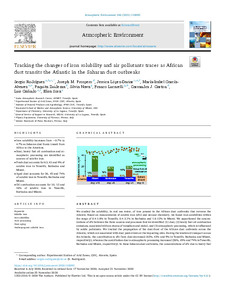Por favor, use este identificador para citar o enlazar este ítem:
http://hdl.handle.net/20.500.11765/12593
Tracking the changes of iron solubility and air pollutants traces as African dust transits the Atlantic in the Saharan dust outbreaks
Registro completo de metadatos
| Campo DC | Valor | Lengua/Idioma |
|---|---|---|
| dc.contributor.author | Rodríguez González, Sergio | es_ES |
| dc.contributor.author | Prospero, Joseph M. | es_ES |
| dc.contributor.author | López-Darias, Jessica | es_ES |
| dc.contributor.author | García Álvarez, María Isabel | es_ES |
| dc.contributor.author | Zuidema, Paquita | es_ES |
| dc.contributor.author | Nava, Silvia | es_ES |
| dc.contributor.author | Lucarelli, Franco | es_ES |
| dc.contributor.author | Gaston, Cassandra J. | es_ES |
| dc.contributor.author | Galindo, Luis | es_ES |
| dc.contributor.author | Sosa, Elisa | es_ES |
| dc.date.accessioned | 2020-11-30T09:42:14Z | - |
| dc.date.available | 2020-11-30T09:42:14Z | - |
| dc.date.issued | 2021 | - |
| dc.identifier.citation | Atmospheric Environment. 2021, 246, 118092 | es_ES |
| dc.identifier.issn | 1352-2310 | - |
| dc.identifier.uri | http://hdl.handle.net/20.500.11765/12593 | - |
| dc.description.abstract | We studied the solubility, in real sea water, of iron present in the African dust outbreaks that traverse the Atlantic. Based on measurements of soluble iron (sFe) and aerosol chemistry, we found iron solubilities within the range of 0.4–1.8% in Tenerife, 0.4–3.1% in Barbados and 1.6–12% in Miami. We apportioned the concentrations of sFe between the three sources and processes that we identified: (1) dust, (2) heavy fuel oil combustion emissions, associated with an excess of vanadium and nickel, and (3) atmospheric processing, which is influenced by acidic pollutants. We tracked the propagation of the dust-front of the African dust outbreaks across the Atlantic, which are associated with dust peak events at the impacting sites. During the westward transport across the Atlantic, the contribution to sFe from dust decreased (63%, 42% and 11% in Tenerife, Barbados and Miami, respectively), whereas the contribution due to atmospheric processing increased (26%, 44% and 80% in Tenerife, Barbados and Miami, respectively). In these Saharan-dust outbreaks, the concentrations of sFe due to heavy fuel oil combustion were significantly lower (mostly < 5 ng/m3) than those in the polluted marine atmosphere (10–200 ng/m3). The overall results are consistent with the idea that the mixing of dust with acid pollutants increases the solubility of iron during the African-dust outbreaks that traverse the Atlantic. | es_ES |
| dc.description.sponsorship | The project AEROATLAN (CGL 2015-66299-P), is funded by the Ministry of Economy and Competitiveness of Spain and the European Regional Development Fund. M.I.G. was awarded with a grant provided by the Canarian Agency for Research, Innovation and Information Society, co-funded by the European Social Funds. | es_ES |
| dc.language.iso | eng | es_ES |
| dc.publisher | Elsevier | es_ES |
| dc.rights | Licencia CC: Reconocimiento CC BY | es_ES |
| dc.subject | Soluble iron | es_ES |
| dc.subject | Iron solubility | es_ES |
| dc.subject | Acid processing | es_ES |
| dc.subject | Dust aging | es_ES |
| dc.subject | Anthropogenic soluble iron | es_ES |
| dc.title | Tracking the changes of iron solubility and air pollutants traces as African dust transits the Atlantic in the Saharan dust outbreaks | es_ES |
| dc.type | info:eu-repo/semantics/article | es_ES |
| dc.relation.publisherversion | https://dx.doi.org/10.1016/j.atmosenv.2020.118092 | es_ES |
| dc.rights.accessRights | info:eu-repo/semantics/openAccess | es_ES |
| Colecciones: | Artículos científicos 2019-2022 | |
Ficheros en este ítem:
| Fichero | Descripción | Tamaño | Formato | ||
|---|---|---|---|---|---|
| j_atmosenv_2020_11809... | 5,69 MB | Adobe PDF |  Visualizar/Abrir |
Los ítems de Arcimis están protegidos por una Licencia Creative Commons, salvo que se indique lo contrario.





